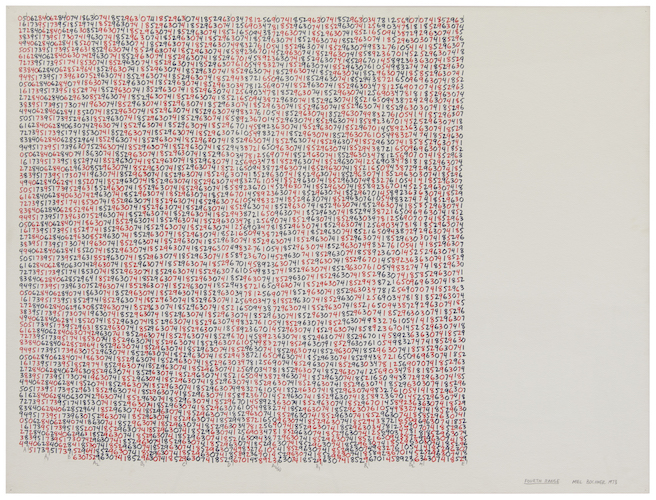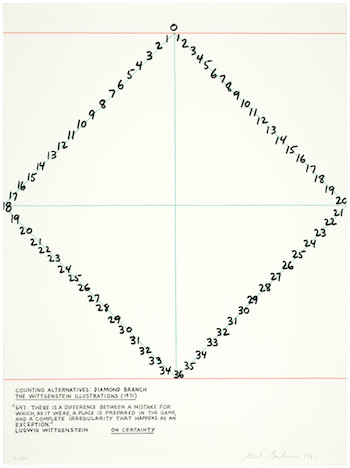Visual Arts Review: “Mel Bochner: Illustrating Philosophy” — The Art of Picturing Ideas
These drawings are invitations to view the world in an active way, speculative aesthetic instruments whose purpose is to encourage us to exercise (and stretch) our minds.
Mel Bochner: Illustrating Philosophy at the Mount Holyoke College Art Museum, South Hadley, MA, through December 20.

Mel Bochner, “Fourth Range,” 1973, Ink on paper, Reproduced with permission from the artist.
By Kathleen C. Stone
Mel Bochner’s art is informed by ideas – mathematics, philosophy, semiotics. One of the early conceptualists, he has been working in this vein since the 1960s. A prime example of his exploration of the intersection between abstract ideas and the visual is on view at the Mt. Holyoke College Art Museum in an exhibition of drawings in which Bochner takes on a heady challenge — illustrating the philosophy of Ludwig Wittgenstein, one of the most notoriously thorny thinkers of the 20th century.
How can a drawing illustrate philosophy, you might ask. A fair question. These particular drawings were inspired by one of Wittgenstein’s books, On Certainty, in which the German philosopher explored epistemological ideas – it dissects the conventional notions of knowledge and certainty that underlie our systems of language and numbers. Published in 1969, after Wittgenstein’s death, the volume pits a hypothetical skeptic, who asserts that all our beliefs could be mistaken, against the philosophical view that at least some things can be known with certainty. This counter-positioning of thought gives Bochner a wide dramatic field in which to play.
The drawings are arrangements of numerals, black on white paper. They were printed in 1991, in conjunction with a premium edition of On Certainty, printed by Arion Press with an introduction by art critic Arthur Danto. (The Mt. Holyoke show also includes two earlier drawings.) Each is laid over a quincunx shaped matrix, a square with four lines running from the paper’s midpoint to its corners. The matrix, given its fixed arrangement, seems both knowable and certain.
The numerals are less certain, however. Bochner has arranged rows of numbers in sequence along the grid lines, and the eye easily follows them out to the corners. Yet, as orderly as this may seem, there are surprises. For instance, there is the assumption that a line of numbers with fifteen as the midpoint must start with zero and end on thirty. But that’s not necessarily what happens in Bochner’s hands.

Mel Bochner, “Diamond Branch,” from the portfolio “Counting Alternatives: The Wittgenstein Illustrations, 1991”; based on drawings from 1971, Planographic print on T.H. Saunders English mould-made paper. Reproduced with permission from the artist.
In one drawing, the vertical line starts at zero, arrives at fifteen in the middle of the page, but ends on twenty-eight. From the midpoint, the horizontal lines extend left and right but end on twenty-six and twenty-seven. Even more confoundingly, the diagonal lines end on thirty and thirty-one. Visually, nothing looks off center, but subtle variations among the hand-drawn numbers produce unexpected and subtly surprising results. When the lines fail to end where we think they should, doubt collides with certainty.
In another drawing, Bochner starts with the same matrix and draws the numerals one through fifteen on the center vertical line. When he reaches that midpoint, he must decide on his next move. Continue the vertical descent? Make a sharp turn, left or right, along the horizontal axis? Branch diagonally, either up or down? Stay in sequence or skip a number? Here, he chooses to run the sequence along the diagonals, producing a design in the shape of an upside-down Y; we are left to think about the meaning of choice in the context of a prescribed universe.
Bochner has always been a thoughtful and thought-provoking artist. He studied philosophy in school along with art, and he is obviously comfortable gamboling with abstract ideas. His considerable catalogue includes installations, drawings, and compilations of words that invite us to re-think such concepts as geometry, counting, spatial relations, and objective reality.
Although his work recalls that of Dorothea Rockburne and Cy Twombly, Bochner has always had his own ideas about art. “I do not make art. I do art,” Bochner said in 1971, the same year he began the drawings on which the present show is based. The observation remains apt. These drawings are attractive to look at, with their straight lines and minimal color palette, but how they look is really not the point. They are invitations to view the world in an active way, speculative aesthetic instruments whose purpose is to encourage us to exercise (and stretch) our minds. It is possible to imagine Wittgenstein saying “I do not write philosophy. I do philosophy.” Both artist and philosopher are committed to a common goal — enticing us to re-examine ideas that are both profound and elemental.
Kathleen C. Stone is a writer pursuing her MFA degree, a lawyer who earned her JD many years ago, and, even before that, was a student of art history. Her blog can be found here.
